President's Message
Hope sprigs eternal. As defined, "It is human nature to keep on hoping against all odds." The particular expression was coined by the poet Alexander Pope in "An Essay on Man" (1732), "Hope springs eternal in the human breast," and very quickly became proverbial."
Shortly after our March 2020 quarterly meeting, we realized it would be prudent to issue a cancellation notice for the next scheduled meeting of June 7th because of the pandemic, hoping that by September we would have a better idea of when the Henrico County Historical Society could meet again safely.
By September the transmissions were up and by December the situation was not much better. We were able to resume the quarterly newsletter, thanks to our editor, Joey Boehlig. Many buildings and meeting spaces had not yet reopened. The vaccinations were being distributed by March of 2021 but were age restricted and still not in the majority. Many thanks to Director of the Tuckahoe District, John Hoogakker, for rescheduling the meeting of June 6. After consulting with other historical societies, we found some had not resumed in person meetings. Some who have museums and research libraries were open by appointment. The pandemic recovery is well under way, however, some restriction still apply. Although we hoped to meet in June a decision was made by the Henrico County Historical Society Executive Board to postpone the next quarterly meeting until later in the year.
In the December issue of the HCHS newsletter, I mentioned that Mr. R. F. Helm donated his research on the history of the shores of the James River which included the possibility of a new discovery. Not wanting to keep any of you in suspense with my note of more to come later and stay tuned, I thought I would follow up. I had not heard back from an inquiry to Mr. Helm when the newsletter went to print.
Time to put our history detective hats on! The top of interest relates to Westham Foundry.
According to state records, the public foundry at Westham was approved by the 5th revolutionary convention in 1776. "The foundry complex included eight blast furnaces, a boring mill, and the foundry, besides all the buildings necessary to house workers and store supplies. The buildings were burned by Lieutenant Colonel John Graves Simcoe and his troops on 5 January 1781 in conjunction with Benedict Arnold's raid on Richmond." There are no records that the foundry was ever in operation again although a report indicated at least one of the buildings did not burn completely and funding was requested to replace the damaged roof. Here is where the mystery begins:
My family has a copy of a letter written by our ancestor JAmes Conner to his brother Tom. In the letter James tells of his job and the address is Westham Foundry, Richmond, VA. The date of the letter is October 16, 1869.
My question to Mr. Helm was, could this letter be the missing link and if the Westham Foundry may bot have ceased operation? Mr. Helm's opinion is that the location may have been the Westham Blast Furnace that started production in 1860 just upstream from the Revolutionary War Westham Foundry location. Much of history, outside of collective memory, can only be established by written records. Found on the Libary of Virginia website: "The records of the first auditor of public accounts have not survived intact; periodically they have been subjected to disarrangement or destruction. When the auditor's office was created in 1776, Virginia's seat of government was in Williamsburg. In 1780, when the capital was moved to Richmond, the auditors and their records also moved. At this time, and during Benedict Arnold's raid on Richmond in 1781, some auditor's records were misplaced or destroyed. During the War of 1812 when it was believed that British troops were marching on Richmond, the state's records were loaded onto wagons and hauled to the James River for transportation upstream. Before the boats sailed, however, the alarm proved false and the records were unloaded and returned to the State Capitol.
The next threat to the auditor's records came on the night of 2-3 April 1865, when the evacuation fire broke out as the Confederate garrison abandoned the city. Fortunately, the auditor's records escaped the flames because they were stored in the basement and attic of the State Capitol, which did not burn. Following the capture of Richmond by Union troops, however, a detachment of the Twentieth New York Infantry Regiment served as a guard in the Capitol building and browsed through the records of the state's fiscal offices (sometimes recording candid opinions concerning the late Cofederacy in the margins of ledgers and journals). After the state library building was completed on the east side of Capitol Square in the late 1890s, the auditor's office moved into it and the older records were stored in the basement. There they remained until 1913, when they were transferred to the custody of the state library
While the mystery of Westham Foundry may never be completely solved it is an example of how new discoveries can be made by finding clues hidden in plain sight in our own possession, those of relatives or even in storage at Museums or Historical Societies.
We thank you for your continued support. Stay safe and we hope to see you real soon!
Sarah Pace
President
>Back to Top<
March Meeting Cancelled

We anticipate meeting on September 12th at Libby Mill Library. We look forward to seeing you there!
More to come in the September newsletter.
>Back to Top<
HPAC Awards of Merit Presented

The Historic Preservation Advisory Committee presented its 2020 Awards of Merit at Dorey Park on May 13. Recipients and representatives recognized were:
Richmond Beeristoric, LLC for their work to preserve, promote and celebrate the history of the local beer brewing community (Represented above by Jacob Brunow, Annie Tobey, Lee Graves, Mike Killelea, Eric Mink, Mike Gorman);
Randy Welch for his preservation of Civl War battlefields through conservation easements and land donations;
Winston and Joyce Devisser for the generous donation of historic Springfield Schoolhouse to further preserve the history of African American schools in Henrico (Winston Devisser);
Sam Watkins for his volunteer work restoring and operating Civil War cannons for display and special events;
Anderson Cemetery League for the recovery and protection of a community history through the restoration of an 1860s African American cemetery (Represented by Wilbert Lawrence, Pam Greene, Thomasine Wilbert).
>Back to Top<
Progress at Meadow Farm
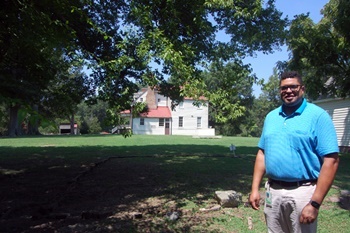
HCHS has significantly advanced its fund raising to support the creation of a 19th Century Interpretive Kitchen building at Meadow Farm Museum, and Henrico County has made a significant commitment to funding the project. An early version of the architectural plans shows a frame building architecturally sympathetic to the other farm buildings and consistent with evidence of the original (no longer existing) separate kitchen.
The project schedule anticipates completion of construction and the beginning of interpretive programs in mid-2022. Meadow Farm Museum portrays rural Virginia life circa 1850 and is currently enhancing programs and facilities representing various populations at the property including African-Americans and indigenous peoples.
Watch for excerpts from the architectural plans in future newsletters.
Meadow Farm site manager Julian Charity stands by the brick outline of the planned kitchen location.
>Back to Top<
Remembering One of the Fallen
All who have served our country deserve to be recognized, and those who lost their lives in doing so deserve a special place in our memory. So we are adding one name to the list of those men who lost their lives when the USS Henrico was struck by a suicide bomber in World War II. Paul Karp realized that his great uncle, Master Sgt. William Mantle, had been left off a list of casualties from the HCHS website.
HCHS received the list of casualties from the USS Henrico Reunion Association. The USS Henrico Reunion Association was focused on records of those serving aboard the USS Henrico, and their list of servicemen killed in the attack included the officers and (perhaps an incomplete) list of enlisted men serving on board the USS Henrico; unfortunately, their list didn't include the names of the US Army servicemen being transported at the time of the attack.
Mr. Karp wrote the following to us that we are sharing with you on this Memorial Day:
"On this Memorial Day, I want to honor the memory of a true hero of my family. My great uncle, Master Sgt. William (Bill) Mantle gave his life fighting for freedom and defending our country.
Uncle Bill was assigned to the USS Henrico which was a battle transport ship. After the invasion of Guam, the Henrico was tasked in March and April of 1945 to participate in the Battle of Okinawa. They were assigned to the “Keramo Retto” attack group. The Kerama Islands were heavily defended by the Japanese as they knew that these Islands would have to be taken by the Americans to be used as a staging area for the ultimate assault on Okinawa. The Island group was slightly south and east of Okinawa.
During the war, my Uncle Bill formed a friendship with the son of John D. Rockefeller, Winthrop Rockefeller. They were both in the 77th Infantry Division of the US Army and became friends. This was exciting for our family. It was hard to get news at that time about what Uncle Bill was doing and where he was. There would sometimes be news articles about Winthrop Rockefeller and the family would then have an idea of where Uncle Bill was and what he was doing.
In Mid April of 1945, the family became worried as there were news reports that Major Rockefeller was burned about the hands and face on April 2nd, 1945 when a suicide bomber hit the ship that he was on. In the news report was mention that men on the ship had died in the attack.
Tragically, in mid May 1945, the family received the news that Uncle Bill had been killed in action on April 2nd, 1945.
On this Memorial Day weekend, I honor the memory of Master Sgt. William (Bill) Mantel. A hero to our family and a hero of our great country."
This Memorial Day, Henrico County Historical Society is proud to recognize Master Sgt. Mantle. We join with all of you in remembering Master Sgt. Mantle, the servicemen aboard the USS Henrico who perished, and all the brave souls who died while serving in the US military.
Below left: Master Sgt. William Mantle, one of the casualties of the suicide bombing attack on the USS Henrico. Below right: Master Sgt. Mantle was temporarily buried on Zemami Jima, part of the Kerama Island Group of Okinawa.

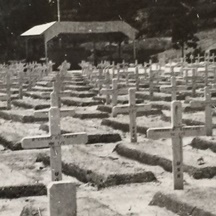
>Back to Top<
Inventive Henricoans
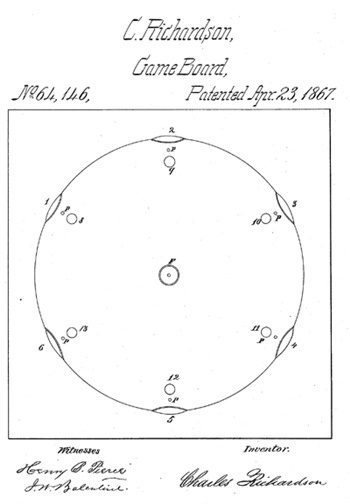
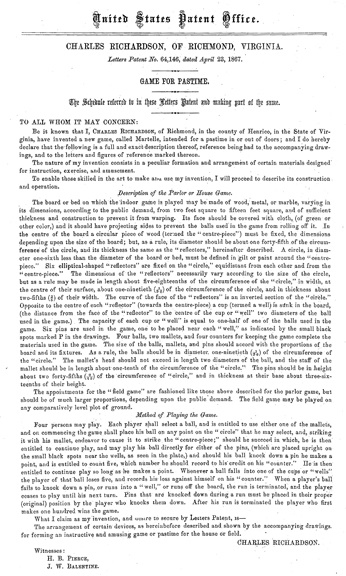
Charles Richardson was, it seems, somewhat of a nineteenth century gamer, receiving two different patents for games - one for the version of croquet called Martelle (seen here) and one for a chess variation called War Chess. Martelle, which seems to combine elements of croquet, billiards, and bowling, was intended as a board game and could be adapted for outdoor play.
Playing Martelle outdoors: An etching from the 29 January 1867 Harper's Magazine shows couples enjoying a genteel roud of Richardson's croquet variation.
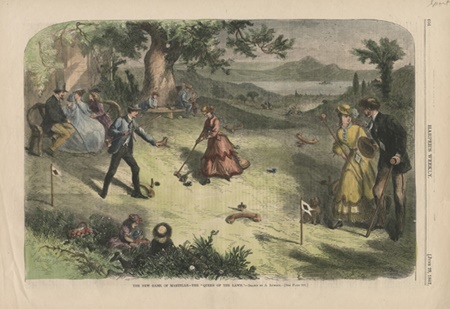
Marketing the game: This ad from an 1857 Harper's Magazine, obviously before the patent was awarded, offers game instructions for ten cents. The actual game, it seems was never manufactured.
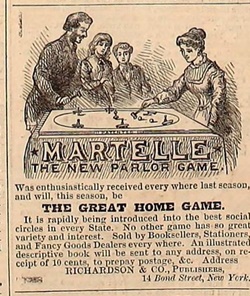
>Back to Top<
Going Places and Stealing Bases: Bobby Winston
Baseball season has begun, and it always make me think of the days I spent collecting baseball cards, taking them to school and challenging other collectors to see who could sling or flip his closest to the wall and win the other's card. The gold standard of the day was the Mickey Mantle card, and it was a rare time when anyone risked one in a contest. His 1951 rookie card is valued today at $125,000, and all of his cards rate in the thousands.
The value of this baseball icon's card is not a real surprise, but a card featuring a team I had never heard of before researching this article did surprise me. It was a Real Photo Postcard of the 1909 Chicago Leland Giants, a team from the Pre-Nego Leagures. It came from the family of Rube Foster, a player, manager, and executive in the Negro National League. Known as the "Father of Black Baseball", he was inducted into the Baseball Hall of Fame in 1981. The sepia card sold at auction for over $15,000, but its interest to me was the stocky ballplayer third from the right on the front row - one Bobby Winston, the left fielder from Henrico County, seated net to team owner Frank Leland.
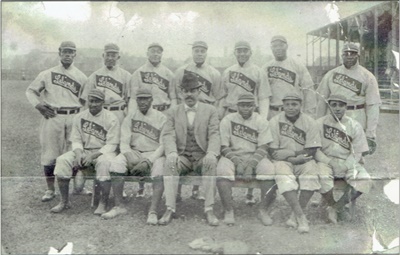
Clarence Henry Winston, who as a player went by the name of Bobby Winston, was born on 27 August 1878 in the Brookland area to Richard Winston and Mary Wallace. In the 1900 census, he, his mother Mary Winston and his sister Cora are found living in the Brookland area with his grandmother Dinah Wallace, working as a cattle herder.
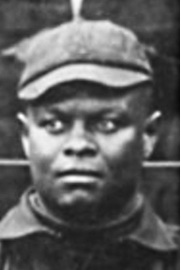
His earliest stint in baseball was local when he played and served as captain and manager for the True Reformers All-Stars. He started with them in 1900, and a couple of brief accounts of their games indicate the play might have been rough and was very popular. The 28 July 1901 Times ran an article whose subhead said "They Defeat the Manchester Grays in a Game Devoid of Incident." The Reformers beat the Grays 14-4 in a "battle for the Afro-American championship of the two cities;" and the writer seemed surprised that "There was no fight" and that "Only one player was struck by a pitched ball, and he did not resent it." The team's popularity was reflected in a brief piece in the 29 April 1903 Times-Dispatch that said, "In the presence of the largest crowd that has visited Broad Street Park since the football contenst between Virginia and North Carolina last fall, the True Reformers walloped the New York Stars in a game of base-ball yesterday afternoon." Wallop them they did - by a score of 25-4.

In 1905, Bobby Winston signed with the Norfolk Red Stockings (pictured above, Bobby Winston is second from the left on the front row) and then left in August to play for the Cuban X-Giants (picture below, Bobby Winston kneels on the front row, second from left). He played with them until 1907, when he went to the Leland Giants, who later became the Chicago American Giants. The left-hand batting left fielder stayed with squad until 1921, racking up a .271 career batting average, hitting well over .300 for a number of seasons. Those teams traveled widely, playing fewer games per season than major league teams of the time; but Seamheads.com, a database for the Negro Leagues, projected Winston's numbers across a 162-game schedule and concluded that his 161 career stolen bases was the equivalent of an 81-steal season. In fact, the 1910 pamphlet "Frank Leland's Chicago Base Ball Club" said this of this speed: "on the Havana team in the Cuban National League ... his daring base running was the feature of the entire league. All Chicago is familiar with Bobby's wonderful ability to steal the sacks."
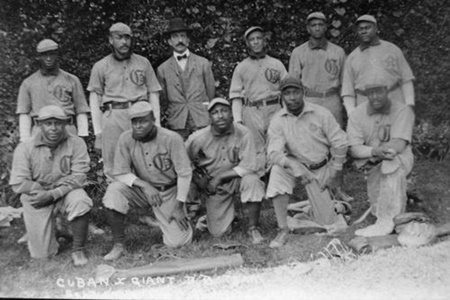
And it was ability that landed Winston with the Leland club because the team played what was known at the time as "scientific" baseball. In "Straddling the Color Line: The LeLand Giants and the Negro Leagues at 100," Justin Broubalo characterizes it as "emphasizing carefully-executed plays using good fundamentals over flashy acts of showmanship (historyassociates.com)."
Their adoption of scientific baseball, however, was not the only thing that marked the Leland Giants as unique. They played in Chicago's city league and were the only all black team in the otherwise all-white league. And after winning the league championship with a 31-9 record, the 1909 Giants concluded their season by playing a three game series against the Chicago Cubs, the winners of the World Series in the two previous seasons. Unfortunately, they lost all three.
Their serious approach to the game did not, however, eliminate boasting and challenges. Rube Foster apparently took offense at a writer who named two other pitchers in the league who were superior to him. In a letter printed to the Philadelphia Tribune reprinted in the Nashville Globe of 19 July 1907, he listed the times he had beaten both pitchers, then wrote the following: "I furthermore issue the following challenge: Will play the Philadelphia Giants in Philadelphia or anywhere, for any amount they care to play for, and would give anything for that 'winner take all gag' of theirs." The article went on to say that "A comparison with the box scores shows that ... Winston, Payne, Rose, Booker, and Gatewood, of the Leland Giants, are youngsters that are doing ... as good work as any of the veterans and in many instances excel."
That article also illustrates a bit about the economics of the game by referring to a Fourth of July game the Giants played. It says "the Leland Giants realized $525 as their share for the two games played against the [Chicago] Gunthers." After adjusting for inflation, that was just under $15,000 in today's dollars.
And Bobby Winston was clearly resilient. 1909 was not a high point for him when he broke his ankle, joining two other Giants who suffered broken legs in that season. But he came back strong, and several refererences to Winston's abilities appear in newspapers of the following year. For example, Alex Irvin, identifying himself as an ex-Ball Player, wrote in the 21 July 1910 Twin City Star that "As out fielders, Winston and Moore are a tower of strength to their club ... Bobby Winston, is a left hand titter [sic] who has mastered the art of 'hitting to left field,' and fans know what value this is." And the 27 August 1910 Indianapolis Freeman noted that "Bobby Winston, who is way up in the City League averages, is still hitting the ball hard."

And the Chicago Giants, the baseball they played as well their competition were often praised. For example, a 2-0 win over the Indiana Harbor team on 15 October 1911 led to an article the following day in theLake County Times that called the Giants "one of the best semi-pro teams in Chicago." And the game compared favorably with major league games, as the writer said, "there is no doubt a great many who went into Chicago to witness the Sox-Cub game at Comiskey park would have stayed at home and seen a good brand of ball and had lots of fun at the same time."
It's difficult to say how Winston would have fared had he been given a chance to play major league ball, but a 13 July 1942 article in the Michigan Chronicle said he belonged there. Under the headline "Colored Ball Stars Who Should Have Been in the Majors," it called for the breaking down of the color line in baseball, and said, "For instance, back at the turn of the current season, players like ... Andrew (Rube) Foster, ... Bobby Winston, and a large number of others showed that skill which marked them as outstanding individuals in their respective positions, ability which stamped them the equal of players in any league."
After the 1921 season, Bobby apparently remained in Chicago for an undertermined period of time. References to his whereabouts are slim, but his 1942 draft registration card lists him as a waiter at the Illinois Athletic Club. Sometime thereafter he moved to Richmond, where he died at St. Philip Hospital on 15 September 1952. Clarence Henry "Bobby" Winston is buried in Evergreen Cemetery.
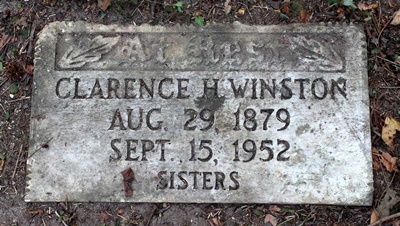
Joey Boehling
>Back to Top<
What Do You Know?
This 4-inch tall plastic object is about a inch in diameter and has wires coming out of opposite sides of its base.
Do you know what it is?
Email your answers to:
jboehling@verizon.net
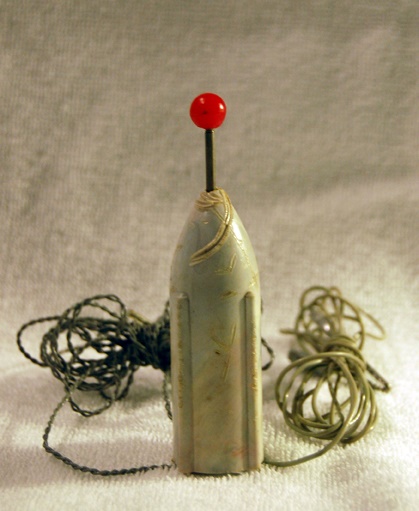
>Back to Top<
Now You Know
To calm the bees, apiarists had to ... Smoke 'em out
We have a swarm of people to congratulate for identifying the "What Do You Know" object in the last newsletter, so here's the lengthy list: James Noll, Causey Davis, Randall Benton, Anne Jackson, John Jacobsen, Mary Jo and Haywood Wigglesworth, Kate Ridgeway and Chelsea Blake. The object was an antique bee smoker, which was used to blow smoke into beehives to sort of stun the bees, thereby allowing the beekeeper to harvest the honey.
This type of smoker was invented in 1873 in Mohawk Valley, NY by Moses Quimby. It features a conical top that was hinged so that fuel could be placed in the tin can and burned. Fuels included burlap, pine needles, corrugated cardboard, paper egg cartons, and rotten wood or herbs.
As a puff of anesthetizing smoke was needed, the honey harvester would gently depress the bellows to expel one.
Beekeeping has a long, long history, with the earliest image of humans gathering honey dating back over 7,000 years to the Arana in eastern Spain. The ancient Egyptians kept bees, as did the Greeks and Romans amonng others, including indigenous Native Americans, who burned puffball fungus to calm the bees.
The housing for domesticated bees varied from pottery hives to woven conical baskets called skeps to today's boxes.
Beekeeping through the ages: The earliest image of honey, gathering found in caves in eastern Spain. Peter Bruegel's Medieval painting The Beekeepers, showing beekeepers tending their skeps; the bee smoker from the last issue's "What Do You Know?"; a seventh century B.C. decoration from the Egyptian tomb of Pabasa showing a beekeeper; the oldest found beehives from 900 B.C. in Israel, consisting of clay and straw tubes stacked like a woodpile. Each tube was approximately 2.5 feet long and 1 foot in diameter with a removeable plug at one end to allow access to gather honey and a small hole at the other end to allow access for the bees.
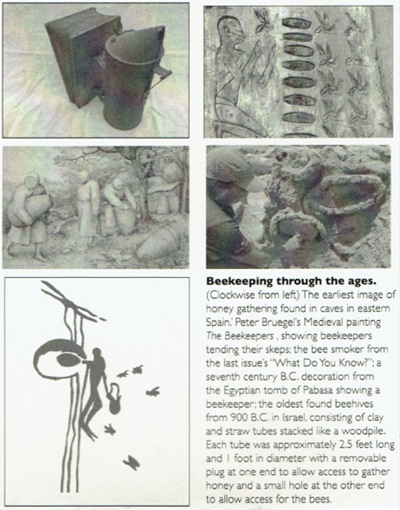
>Back to Top<
News 2021: Second Quarter
First Quarter | Third Quarter | Fourth Quarter
Home | Henrico | Maps | Genealogy | Preservation | Membership | Shopping | HCHS
|











